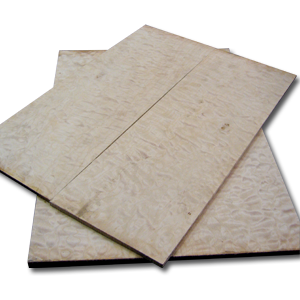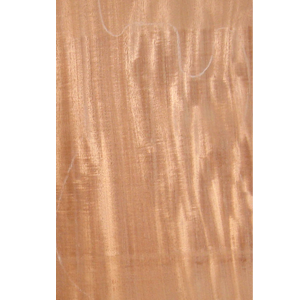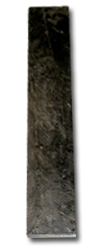Choosing the right wood for any guitar project can be tricky. Different types of guitar wood provide different types of structure and also create many different types of tones. Your choice of guitar wood should not only reflect the type of guitar you are starting to build, but it should also reflect your playing style. I decided to go with a Honduras Mahogany back, highly Quilted Maple top, and beautiful Macassar Ebony neck.
Guitar Body Wood
Contents
 After planning and making decisions about the overall feel of this guitar, I decided that I wanted the body to be 1.75″ thick. Keep in mind; this is the entire thickness of the body–not just the back. I also decided that I wanted a full 1/2-inch maple top. Some guitars only use a 3/8-inch top or even a 1/4-inch top. I like the way a full 1/2-inch top looks when it is carved out. It gives the guitar top great dimension. That being the case, my body back would have to be at least 1.25″ thick.
After planning and making decisions about the overall feel of this guitar, I decided that I wanted the body to be 1.75″ thick. Keep in mind; this is the entire thickness of the body–not just the back. I also decided that I wanted a full 1/2-inch maple top. Some guitars only use a 3/8-inch top or even a 1/4-inch top. I like the way a full 1/2-inch top looks when it is carved out. It gives the guitar top great dimension. That being the case, my body back would have to be at least 1.25″ thick.
It’s obviously important to make sure that you measure your guitar design and thickness before you go out and buy all the wood. You don’t want to spend 100 bucks on a beautiful piece of maple that isn’t usable.
The Guitar Top
Since I wanted my top to be at least 1/2-inch thick, I needed to buy a piece that at least accommodated that. I found this amazing looking quilted maple top that was 1 inch thick. This is perfect. I can cut it down to 1/2-inch and have a nice veneer left over to either do the back of this guitar of do a small top on another guitar. Remember, if you are not buying a book matched piece of wood, you don’t have to find a top that is the total width of your guitar. It only needs to be half the width of your guitar. After you book match the wood, it will be the proper width. My piece of maple was already book matched when I bought it. Obviously, I made sure that my maple top was wide enough to fit my body design.

The Guitar Back
When I was looking for my Honduras Mahogany back, I not only wanted to find a piece that was at least 1.25″ thick, but I also wanted to find a single piece big enough for the whole body. I didn’t want to make a two-piece body because I am planning on staining the back–not painting it. I want it to look clean without any seams. I found a nice piece of Mahogany with beautiful ribbons in it measuring about 2″ thick. This one will work out nicely!
Guitar Neck Wood
Some of the same decisions come up when you are trying to plan your guitar neck as when you are planning the body. How thick do you want it? How wide do you want it? What scale length do you want? You also have to think about a set neck vs. a bolt on neck. All of these questions should be addressed before you buy your guitar neck wood. I decided to build a solid neck with a scarf-jointed headstock. This is not only stronger way to build your neck, it also produces less scrap wood. I also decided to do a deep cut set neck. This is the closest thing to a neck through design as you can get without actually being a neck through. I plan to glue the neck in place about 3/4 the way into the body. This way all the pickups can be mounted directly on the neck. Direct mounting produces much more sustain and increased tone.
After making all of those decisions, I found a highly figured piece of Macassar ebony that measures about 2″ x 4″. This will not only give me enough room to make this neck, I should be able to make a small neck for my neck project.
Guitar Fretboard Wood
 The last piece of wood that I need is the fretboard. There really are too many measurements that need to be considered with a fretboard. You just need to decide the thickness as well as the width of the fretboard. The fretboard width ultimately determines the width of the neck. I decided to make mine about 1/4″ thick. Here are the dimensions of my neck:
The last piece of wood that I need is the fretboard. There really are too many measurements that need to be considered with a fretboard. You just need to decide the thickness as well as the width of the fretboard. The fretboard width ultimately determines the width of the neck. I decided to make mine about 1/4″ thick. Here are the dimensions of my neck:
Fretboard width at the nut: 1 21/32″
Fretboard width at the body: 2 1/4″
Neck depth at the nut: 27/32″
Fretboard radius: 10″
Scale length: 25″
Time to Build!
Now that all the wood is planned, measured, and bought, it is time to start building. Next, I am going to start cutting out the body. I hope this helps you plan and buy your guitar wood for you next project!
